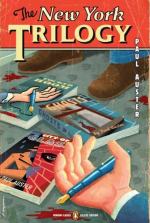|
This section contains 6,783 words (approx. 23 pages at 300 words per page) |

|
SOURCE: “Deconstructing The New York Trilogy: Paul Auster's Anti-Detective Fiction,” in Critique: Studies in Contemporary Fiction, Vol. XXXI, No. 2, Winter, 1990, pp. 71-84.
In the following essay, Russell examines the patterns of representation and meaning in The New York Trilogy based on the theoretical principles of Jacques Derrida. Russell contends that Auster's fiction, with its multiple interpretations and nonlinear movement, resists the conventions of detective fiction and works to “deconstruct logocentrism.”
Detective fiction comprises a genre seemingly at odds with American experimental writing. The detective story's highly stylized patterns are derivative of the Romance, an extremely conventional literary genre. Recent experimental novelists, however, are taking advantage of these conventions to create what Stefano Tani has called “anti-detective fiction.”1 Pynchon's The Crying of Lot 49 and Nabokov's Pale Fire illustrate this postmodern mutation in their parodic forms and subversions of the end-dominated detective story. A more recent example of anti-detective fiction...
|
This section contains 6,783 words (approx. 23 pages at 300 words per page) |

|


